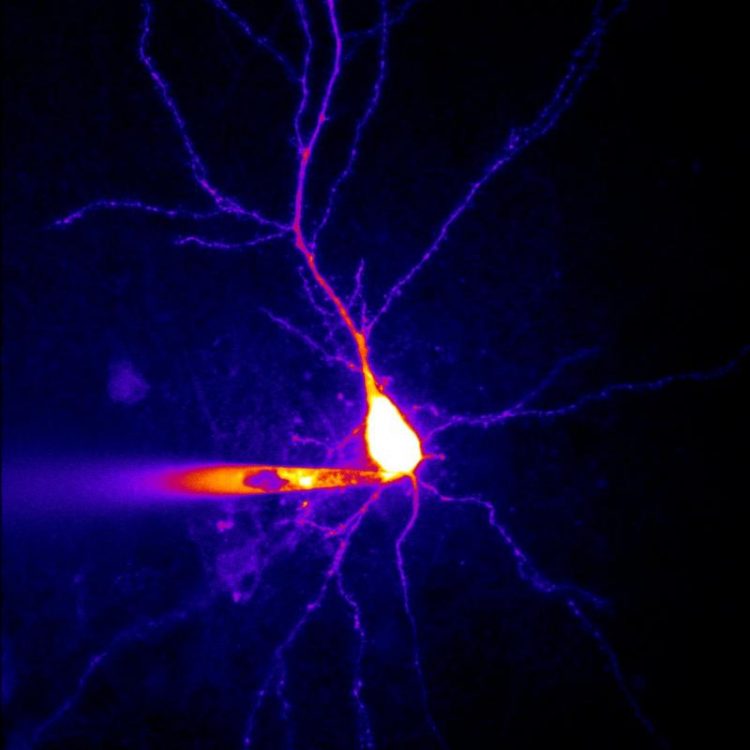Epilepsy: When the neuron's doorman allows too much in

This is how a neuron from the hippocampus of a rat looks like. The cell and it's extenive processes are visulaised using a fluorescent dye, filled via a glass pipette. (c) Photo: AG Heinz Beck/Uni Bonn
In Germany, approximately one out of a hundred people suffer from epilepsy and one out of twenty suffer a seizure at least once during their lifetime. Seizures occur when many nerve cells in the brain fire in synchrony.
Scientists are searching for the causes leading to this simultaneous excitation of brain cells. Researchers at the Department of Epileptology, the Institute for Neuropathology and the Institute for Molecular Psychiatry, together with the Caesar Research Center and the Hebrew University (Israel) have discovered a mechanism which previously was not thought to be involved in the development of epilepsy.
“Doormen” determine how many sodium ions are allowed in
Neurons integrate many inputs together to then determine an appropriate output, and sodium channels play a key role in both processes. “They play an important role in the excitation of nerve cell axons and signal transfer between various cells,” says Prof. Dr. Heinz Beck, who conducts research in experimental epileptology at the Department of Epileptology, at the Life & Brain center and the German Center for Neurodegenerative Diseases (DZNE).
Like a type of door, sodium channels allow sodium ions to flow into nerve cells through tiny pores. They consist of large protein complexes located in the membranes of nerve cells. The scientists found a large increase in a certain sodium influx which significantly increased the excitability of cells in the epileptic animal.
For this reason, scientists working with Prof. Beck initially compared the sodium channel proteins from the brains of epileptic rats to those of healthy animals. “However, this did not reveal any increased formation of sodium channel proteins, which could have explained the overexcitation of nerve cells.” reports the epilepsy researcher.
After a long search, the team of researchers found a completely different group of substances: the polyamines. Spermine belongs to this group; it is produced in cells and plugs the pores of the sodium channels from within. like a doorman. In this case, the influx of sodium ions is blocked and the excitation of the nerve cells is reduced.
Overexcitation is attenuated through administration of spermine
The scientists investigated how much of the seizure-inhibiting substance is present in the nerve cells of rats suffering from epilepsy and compared the values to those of healthy animals. “The amount of spermine in the cells of the hippocampus was significantly reduced in diseased animals as compared to the healthy animals,” report the lead authors Dr. Michel Royeck and Dr. Thoralf Optiz from Dr. Beck's team. “Furthermore, the reduced spermine in the nerve cell led to increased excitability; the cells were more sensitive to input and generated more output” said fellow lead author Dr. Tony Kelly. The investigators tested this important finding, compensating for the deficiency in the nerve cells of epileptic rats by adding spermine back into the cell. As a result, the increase in sodium currents was reversed and the excitability of the neuron returned to normal.
The lower level of spermine in the epileptic rat’s brain was evidently caused by an upregulation of spermidine/spermine-N(1)-acetyltransferase. This enzyme breaks down the spermine which is important in the control of sodium channels. According to the scientists, this result could be a potential starting point for novel epilepsy therapies. “If a substance was available to reduce the activity of acetyltransferase back to normal levels, the lack of spermine and thus the symptoms of epilepsy could be mitigated,” speculates Prof. Beck. However, concrete therapeutic applications are still a long way off.
Publication: Downregulation of Spermine Augments Dendritic Persistent Sodium Currents and Synaptic Integration after Status Epilepticus, The Journal of Neuroscience, DOI: 10.1523/JNEUROSCI.0493-15.2015
Media contact information:
Prof. Dr. Heinz Beck
University Hospital for Epileptology, Life & Brain Center,
German Center for Neurodegenerative Diseases
Spokesperson for Collaborative Research Center 1089
Tel. ++49-228-6885215
E-Mail: Heinz.Beck@ukb.uni-bonn.de
Dr. Tony Kelly
University Hospital for Epileptology, Life & Brain Center,
Tel. ++49-228-6885276
E-Mail: tony.kelly@ukb.uni-bonn.de
Media Contact
More Information:
http://www.uni-bonn.deAll latest news from the category: Life Sciences and Chemistry
Articles and reports from the Life Sciences and chemistry area deal with applied and basic research into modern biology, chemistry and human medicine.
Valuable information can be found on a range of life sciences fields including bacteriology, biochemistry, bionics, bioinformatics, biophysics, biotechnology, genetics, geobotany, human biology, marine biology, microbiology, molecular biology, cellular biology, zoology, bioinorganic chemistry, microchemistry and environmental chemistry.
Newest articles

Compact LCOS Microdisplay with Fast CMOS Backplane
…for High-Speed Light Modulation. Researchers from the Fraunhofer Institute for Photonic Microsystems IPMS, in collaboration with HOLOEYE Photonics AG, have developed a compact LCOS microdisplay with high refresh rates that…

New perspectives for material detection
CRC MARIE enters third funding period: A major success for terahertz research: Scientists at the University of Duisburg-Essen and the Ruhr University Bochum have been researching mobile material detection since…

CD Laboratory at TU Graz Researches New Semiconductor Materials
Using energy- and resource-saving methods, a research team at the Institute of Inorganic Chemistry at TU Graz aims to produce high-quality doped silicon layers for the electronics and solar industries….



